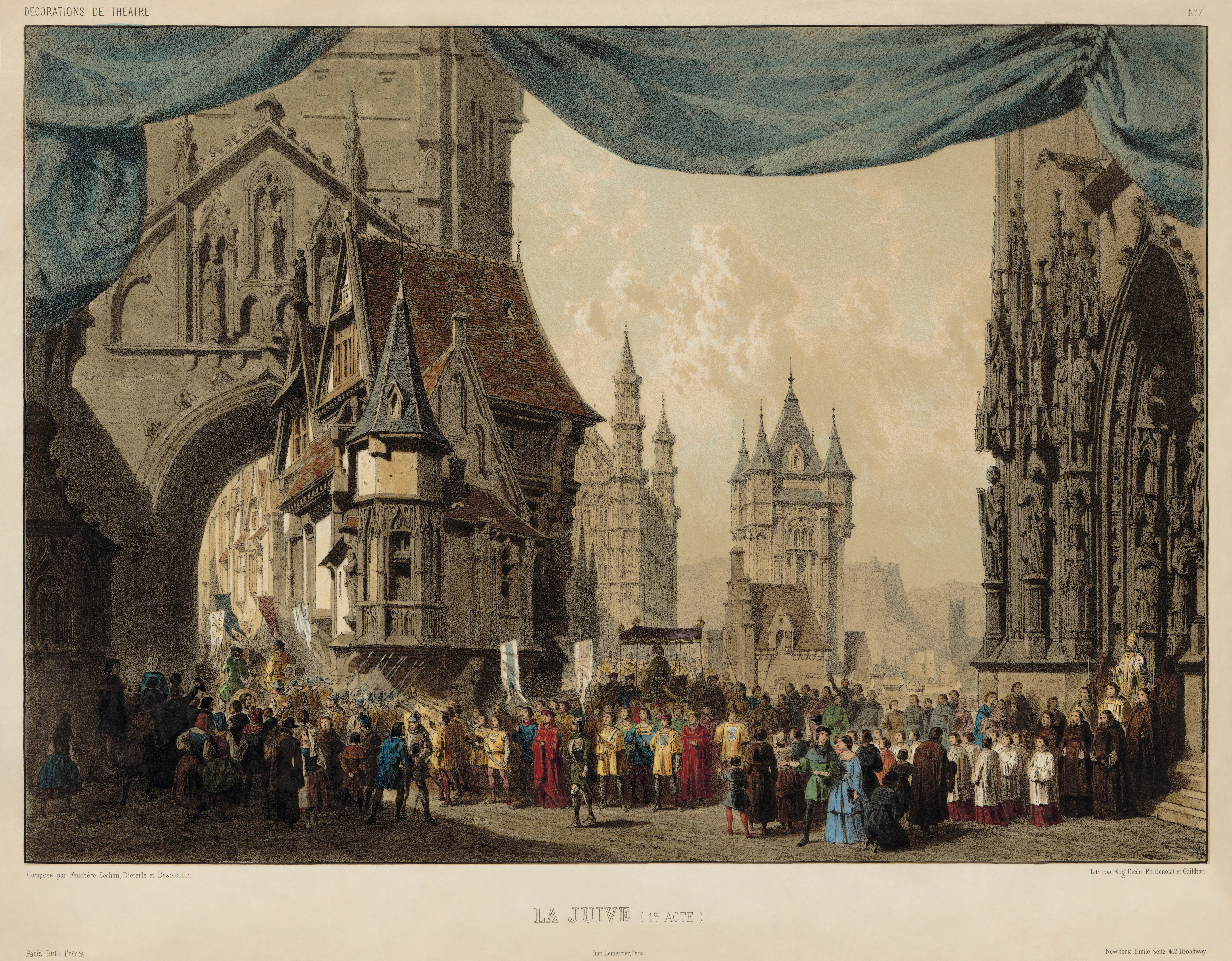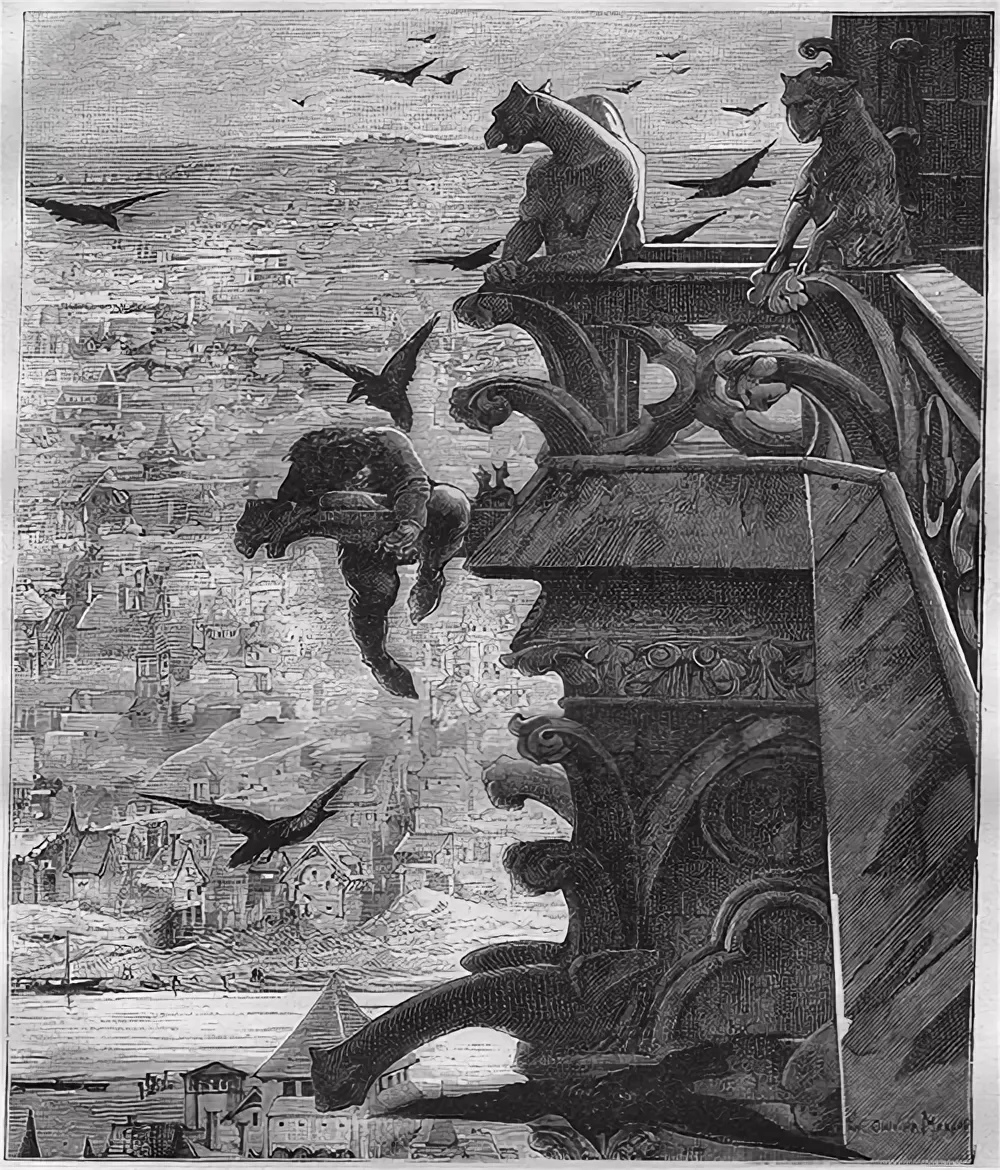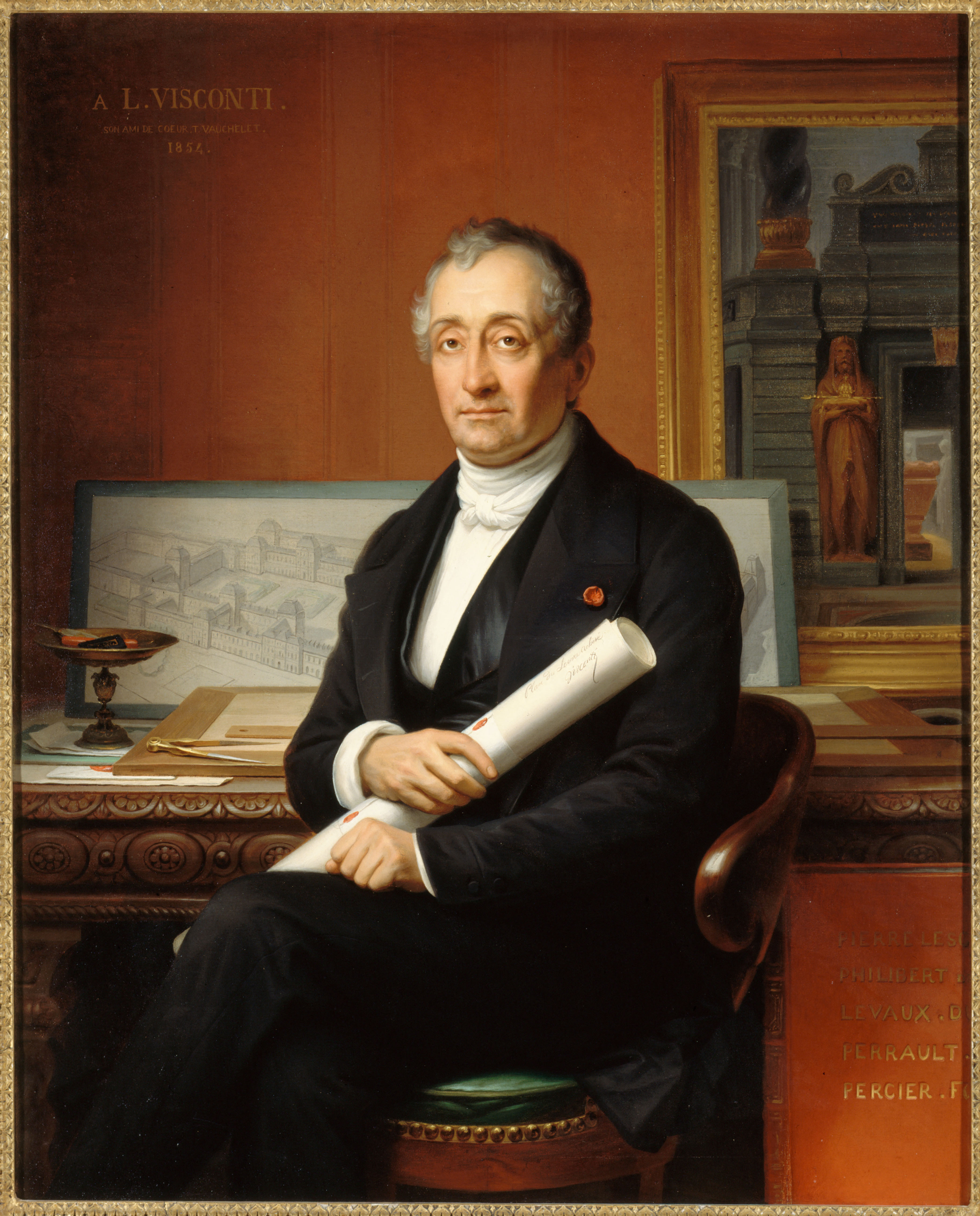|
Louis Philippe Style
The style of architecture and design under King Louis Philippe I (1830–1848) was a more eclectic development of French neoclassicism, incorporating elements of neo-Gothic and other styles. It was the first French decorative style imposed not by royalty, but by the tastes of the growing French upper class. In painting, neoclassicism and romanticism contended to become the dominant style. In literature and music, France had a golden age, as the home of Frédéric Chopin, Franz Liszt, Victor Hugo, Honoré de Balzac, and other major poets and artists. Much of the style was taken from the personality of the King himself. Unlike his Bourbon predecessors, he wore business dress, not formal robes, he lived in Paris, and he shunned ceremonies; he carried his own umbrella, and imposed no official styles. Louis Philippe furniture had the same types and forms as the earlier French Restoration style, but with less decoration; comfort was the primary consideration. The Louis Philippe commod ... [...More Info...] [...Related Items...] OR: [Wikipedia] [Google] [Baidu] |
Louis Philippe I
Louis Philippe (6 October 1773 – 26 August 1850) was King of the French from 1830 to 1848, and the penultimate monarch of France. As Louis Philippe, Duke of Chartres, he distinguished himself commanding troops during the Revolutionary Wars and was promoted to lieutenant general by the age of nineteen, but he broke with the Republic over its decision to execute King Louis XVI. He fled to Switzerland in 1793 after being connected with a plot to restore France's monarchy. His father Louis Philippe II, Duke of Orléans (Philippe Égalité) fell under suspicion and was executed during the Reign of Terror. Louis Philippe remained in exile for 21 years until the Bourbon Restoration. He was proclaimed king in 1830 after his cousin Charles X was forced to abdicate by the July Revolution (and because of the Spanish renounciation). The reign of Louis Philippe is known as the July Monarchy and was dominated by wealthy industrialists and bankers. He followed conservative policies, ... [...More Info...] [...Related Items...] OR: [Wikipedia] [Google] [Baidu] |
Quatremère De Quincy
Antoine-Chrysostome Quatremère de Quincy (21 October 1755 – 28 December 1849) was a French armchair archaeologist and architectural theorist, a Freemason, and an effective arts administrator and influential writer on art. Life Born in Paris, Quatremère de Quincy trained for the law, then followed courses in art and history at the Collège Louis-le-Grand and apprenticed for a time in the atelier of Guillaume Coustou the Younger and Pierre Julien, getting some practical experience in the art of sculpture. A trip to Naples in the company of Jacques-Louis David sparked his interest in Greek and Roman architecture. He was involved in the troubles of the French Revolution. He was a royalist in the National Legislative Assembly of 1791–1792, and his politics were monarchist and Catholic. As a member of the Revolutionary Committee of Public Instruction his set of three ''Considerations on the arts of design in France'' was offered before the Assemblée Nationale at a time (1791) ... [...More Info...] [...Related Items...] OR: [Wikipedia] [Google] [Baidu] |
Prosper Mérimée
Prosper Mérimée (; 28 September 1803 – 23 September 1870) was a French writer in the movement of Romanticism, and one of the pioneers of the novella, a short novel or long short story. He was also a noted archaeologist and historian, and an important figure in the history of architectural preservation. He is best known for his novella ''Carmen'', which became the basis of Bizet's opera ''Carmen''. He learned Russian, a language for which he had great affection, and translated the work of several important Russian writers, including Pushkin and Gogol, into French. From 1830 until 1860 he was the inspector of French historical monuments, and was responsible for the protection of many historic sites, including the medieval citadel of Carcassonne and the restoration of the façade of the cathedral of Notre-Dame de Paris. Along with the writer George Sand, he discovered the series of tapestries called ''The Lady and the Unicorn'', and arranged for their preservation. He was instr ... [...More Info...] [...Related Items...] OR: [Wikipedia] [Google] [Baidu] |
The Hunchback Of Notre-Dame
''The Hunchback of Notre-Dame'' (french: Notre-Dame de Paris, translation=''Our Lady of Paris'', originally titled ''Notre-Dame de Paris. 1482'') is a French Gothic novel by Victor Hugo, published in 1831. It focuses on the unfortunate story of Quasimodo, the Gypsy street dancer Esmeralda and Quasimodo's guardian the Archdeacon Claude Frollo in 15th-century Paris. All its elements—Renaissance setting, impossible love affairs, marginalized characters—make the work a model of the literary themes of Romanticism. The novel has been described as a key text in French literature and has been adapted for film over a dozen times, in addition to numerous television and stage adaptations, such as a 1923 silent film with Lon Chaney, a 1939 sound film with Charles Laughton, and a 1996 Disney animated film with Tom Hulce. The novel sought to preserve values of French culture in a time period of great change, which resulted in the destruction of many French Gothic structures. The nov ... [...More Info...] [...Related Items...] OR: [Wikipedia] [Google] [Baidu] |
Les Invalides
The Hôtel des Invalides ( en, "house of invalids"), commonly called Les Invalides (), is a complex of buildings in the 7th arrondissement of Paris, France, containing museums and monuments, all relating to the military history of France, as well as a hospital and a retirement home for war veterans, the building's original purpose. The buildings house the Musée de l'Armée, the military museum of the Army of France, the Musée des Plans-Reliefs, and the Musée d'Histoire Contemporaine. The complex also includes the former hospital chapel, now national cathedral of the French military, and the adjacent former Royal Chapel known as the , the tallest church building in Paris at a height of 107 meters. The latter has been converted into a shrine of some of France's leading military figures, most notably the tomb of Napoleon. History Louis XIV initiated the project by an order dated 24 November 1670, as a home and hospital for aged and disabled () soldiers. The initial arch ... [...More Info...] [...Related Items...] OR: [Wikipedia] [Google] [Baidu] |
Louis Visconti
Louis Tullius Joachim Visconti (Rome February 11, 1791 – December 29, 1853) was an Italian-born French architect and designer. Life Son of the Italian archaeologist and art historian Ennio Quirino Visconti, Visconti designed many Parisian residences, public buildings and squares, including the Place Saint Sulpice and the overall design of the Fontaine Molière, and was briefly the official architect for the Louvre under Napoleon III. He is probably most famed for designing the 1842 tomb of Napoleon at Les Invalides. His students include Joseph Poelaert, designer of the Palais de justice de Bruxelles. Louis Visconti came from a famous family of archaeologists - his grandfather Giambattista Antonio Visconti (1722–1784) had founded the Vatican Museums and his father, Ennio Quirino Visconti (1751–1818), was a curator. Ennio and his family moved to Paris in 1798 and were naturalised as French citizens in 1799, with Ennio becoming a curator of antiquities and ... [...More Info...] [...Related Items...] OR: [Wikipedia] [Google] [Baidu] |
Saint Helena
Saint Helena () is a British overseas territory located in the South Atlantic Ocean. It is a remote volcanic tropical island west of the coast of south-western Africa, and east of Rio de Janeiro in South America. It is one of three constituent parts of the British Overseas Territory of Saint Helena, Ascension and Tristan da Cunha. Saint Helena measures about and has a population of 4,439 per the 2021 census. It was named after Helena, mother of Constantine I. It is one of the most remote islands in the world and was uninhabited when discovered by the Portuguese enroute to the Indian subcontinent in 1502. For about four centuries the island was an important stopover for ships from Europe to Asia and back, while sailing around the African continent, until the opening of the Suez canal. St Helena is the United Kingdom's second-oldest overseas territory after Bermuda. Saint Helena is known for being the site of Napoleon's second exile, following his final defeat in 1815. ... [...More Info...] [...Related Items...] OR: [Wikipedia] [Google] [Baidu] |
Retour Des Cendres
The ''retour des cendres'' (literally "return of the ashes", though "ashes" is used here as meaning his mortal remains, as he was not cremated) was the return of the mortal remains of Napoleon I of France from the island of Saint Helena to France and the burial in Hôtel des Invalides in Paris in 1840, on the initiative of Prime Minister Adolphe Thiers and King Louis-Philippe. Background After defeat in the War of the Sixth Coalition in 1814, Napoleon abdicated as emperor of the French, and was exiled to the Mediterranean island of Elba. The following year he returned to France, took up the throne, and began the Hundred Days. The powers which had prevailed against him the previous year mobilised against him, and defeated the French in the Battle of Waterloo. Napoleon returned to Paris and abdicated on 22 June 1815. Foiled in his attempt to sail to the United States, he gave himself up to the British, who exiled him to the remote island of St Helena in the south Atlant ... [...More Info...] [...Related Items...] OR: [Wikipedia] [Google] [Baidu] |
July Revolution
The French Revolution of 1830, also known as the July Revolution (french: révolution de Juillet), Second French Revolution, or ("Three Glorious ays), was a second French Revolution after the first in 1789. It led to the overthrow of King Charles X, the French Bourbon monarch, and the ascent of his cousin Louis Philippe, Duke of Orléans. After 18 precarious years on the throne, Louis-Philippe was overthrown in the French Revolution of 1848. The 1830 Revolution marked a shift from one constitutional monarchy, under the restored House of Bourbon, to another, the July Monarchy; the transition of power from the House of Bourbon to its cadet branch, the House of Orléans; and the replacement of the principle of hereditary right by that of popular sovereignty. Supporters of the Bourbons would be called Legitimists, and supporters of Louis Philippe were known as Orléanists. In addition, there continued to be Bonapartists supporting the return of Napoleon's descendants. Back ... [...More Info...] [...Related Items...] OR: [Wikipedia] [Google] [Baidu] |
July Column
The July Column (french: Colonne de Juillet) is a monumental column in Paris commemorating the Revolution of 1830. It stands in the center of the Place de la Bastille and celebrates the — the 'three glorious' days of 27–29 July 1830 that saw the fall of Charles X, King of France, and the commencement of the "July Monarchy" of Louis-Philippe, King of the French. It was built between 1835 and 1840. History A first project for one commemorative column, one that would commemorate the Fall of the Bastille, had been envisaged in 1792, and a foundation stone was laid, 14 July 1792; but the project never got further than that. The circular basin in which its socle stands was realised during the Empire as part of the Elephant of the Bastille, a fountain with an elephant in its centre. The elephant was completed to designs by Percier and Fontaine in semi-permanent stucco, but the permanent bronze sculpture was never commissioned due to pinched finances in the latter days of th ... [...More Info...] [...Related Items...] OR: [Wikipedia] [Google] [Baidu] |
Luxor Obelisk
The Luxor Obelisks (French: ''Obélisques de Louxor'') are a pair of Ancient Egyptian obelisks, over 3,000 years old, carved to stand either side of the portal of the Luxor Temple in the reign of Ramesses II (). The right-hand (western) stone, high, was moved in the 1830s to the Place de la Concorde in Paris, France, while the left-hand (eastern) obelisk remains in its location in Egypt. The Luxor Obelisk in Paris was classified officially as a ''monument historique'' in 1936. Together in Egypt Creation The Luxor Temple predated Ramesses II by about 150 years. During his reign, renovations were made that included the addition of the two obelisks. The obelisks were each carved from a single piece of red granite, quarried about south of Luxor in Aswan, transported on a specially designed barge, and lowered into place with ropes and sand. Physical features The two obelisks were slightly different heights, and the one remaining in Luxor is taller. The shorter obelisk was ... [...More Info...] [...Related Items...] OR: [Wikipedia] [Google] [Baidu] |
Arc De Triomphe
The Arc de Triomphe de l'Étoile (, , ; ) is one of the most famous monuments in Paris, France, standing at the western end of the Champs-Élysées at the centre of Place Charles de Gaulle, formerly named Place de l'Étoile—the ''étoile'' or "star" of the juncture formed by its twelve radiating avenues. The location of the arc and the plaza is shared between three arrondissements, 16th (south and west), 17th (north), and 8th (east). The Arc de Triomphe honours those who fought and died for France in the French Revolutionary and Napoleonic Wars, with the names of all French victories and generals inscribed on its inner and outer surfaces. Beneath its vault lies the Tomb of the Unknown Soldier from World War I. The central cohesive element of the ''Axe historique'' (historic axis, a sequence of monuments and grand thoroughfares on a route running from the courtyard of the Louvre to the Grande Arche de la Défense), the Arc de Triomphe was designed by Jean Chalgrin in 1806; i ... [...More Info...] [...Related Items...] OR: [Wikipedia] [Google] [Baidu] |










